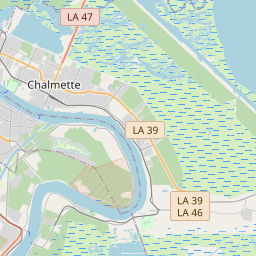Stumpf's Magic Hoodoo
Historical marker location:
Gretna, Louisiana
( Marker can be reached from First Street near Newton Street.)
Marker installed: 2004







© OpenStreetMap contributors
Loading...
Searching for other points of interest within 3 miles of this location.Hurricane Katrina, which struck Louisiana in 2005, was one of the deadliest and costliest hurricanes in U.S. history. The storm caused widespread destruction in New Orleans and other parts of the state, and its aftermath highlighted issues of poverty, race, and government response in the United States.
About Jefferson Parish
Jefferson Parish Timeline
Jefferson Parish, Louisiana has a rich history that dates back to the early 17th century when French explorers first settled in the area. The parish was named after Thomas Jefferson, the third President of the United States, in 1825. Throughout its history, Jefferson Parish has experienced multiple changes in governance and rapid population growth.
In the 18th century, the region of Jefferson Parish was mainly inhabited by Native American tribes such as the Houma, Chitimacha, and Choctaw. However, with the arrival of French explorers and colonizers, the area quickly became a center of trade and commerce. It was during this time that the settlement of Jefferson came into existence.
Jefferson Parish played a significant role in the history of Louisiana during the colonial period and the subsequent Louisiana Purchase. In 1803, the United States acquired the territory of Louisiana from France, including the land that is now Jefferson Parish. This event marked a turning point in the development of the region, as American settlers began to establish plantations and expand the local economy.
In the 20th century, Jefferson Parish experienced a surge in population and urban development. The opening of the Huey P. Long Bridge in 1935 and the construction of the Greater New Orleans Bridge in 1958 greatly improved transportation between Jefferson Parish and its neighboring parishes. This infrastructural growth, combined with the expansion of industries like oil and gas, attracted new residents and businesses to the area.
Today, Jefferson Parish is a dynamic and diverse community that encompasses a variety of cities and towns, including Metairie, Kenner, and Gretna. It is known for its vibrant culture, thriving economy, and diverse population. With its historical significance and continuous growth, Jefferson Parish remains an important part of the greater New Orleans metropolitan area.
In the 18th century, the region of Jefferson Parish was mainly inhabited by Native American tribes such as the Houma, Chitimacha, and Choctaw. However, with the arrival of French explorers and colonizers, the area quickly became a center of trade and commerce. It was during this time that the settlement of Jefferson came into existence.
Jefferson Parish played a significant role in the history of Louisiana during the colonial period and the subsequent Louisiana Purchase. In 1803, the United States acquired the territory of Louisiana from France, including the land that is now Jefferson Parish. This event marked a turning point in the development of the region, as American settlers began to establish plantations and expand the local economy.
In the 20th century, Jefferson Parish experienced a surge in population and urban development. The opening of the Huey P. Long Bridge in 1935 and the construction of the Greater New Orleans Bridge in 1958 greatly improved transportation between Jefferson Parish and its neighboring parishes. This infrastructural growth, combined with the expansion of industries like oil and gas, attracted new residents and businesses to the area.
Today, Jefferson Parish is a dynamic and diverse community that encompasses a variety of cities and towns, including Metairie, Kenner, and Gretna. It is known for its vibrant culture, thriving economy, and diverse population. With its historical significance and continuous growth, Jefferson Parish remains an important part of the greater New Orleans metropolitan area.
Jefferson Parish Timeline
This timeline provides a glimpse into the major events and milestones that have shaped the history of Jefferson Parish, Louisiana.
- December 30, 1803: Jefferson Parish was established as one of the original 19 parishes of the Territory of Orleans.
- 1812: The city of Lafayette (now known as Jefferson) was incorporated as the first parish seat.
- 1863: The city of Jefferson was renamed to Carrollton.
- 1874: The parish seat was moved from Carrollton to the newly established town of Gretna.
- 1884: The town of Jefferson was reincorporated as a city.
- 1926: The parish seat was moved again, this time to the newly created city of Harahan.
- 1954: The city of Gretna was designated as the parish seat once more.
- 1981: The current courthouse in Gretna became the seat of the parish government.
- 2005: Jefferson Parish was severely affected by Hurricane Katrina, resulting in significant damage and loss.